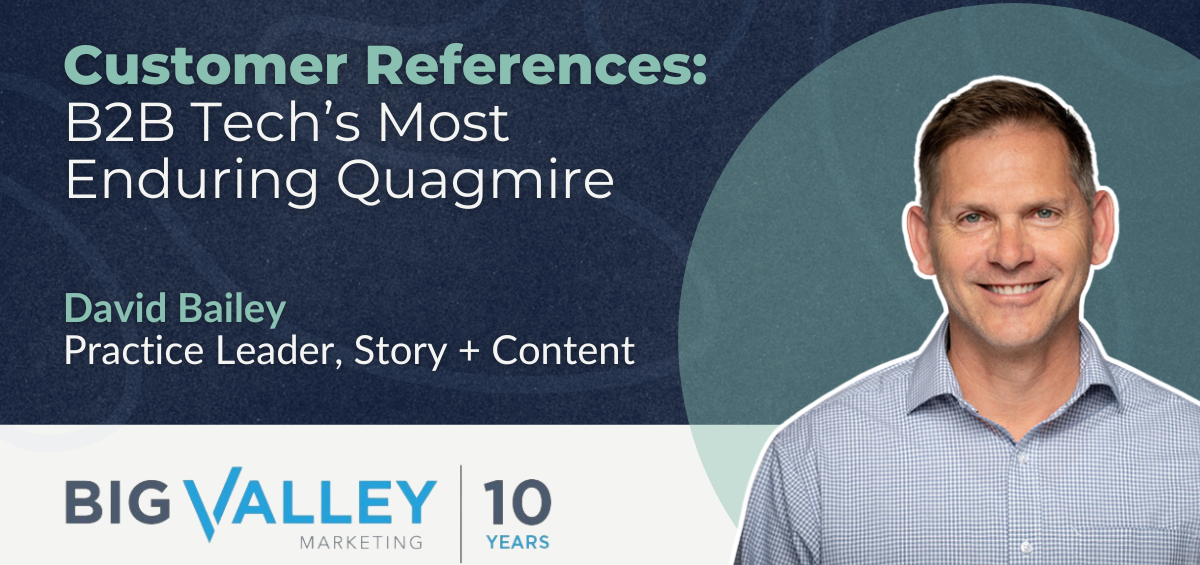Effective strategies for running high-impact customer co-marketing programs.
It’s been nearly five years since I first penned a blog reflecting on how so many companies struggle with running effective, scalable — and genuinely high-impact — customer reference programs.
I felt it was important to revisit the topic and offer some sharper perspective and advice for B2B tech companies who are still trapped in a Sisyphean struggle to roll the customer reference boulder up the hill.
Why is the customer reference still such a challenge? Here are the mistakes we continue to see time and again.
Lack of c-suite engagement. Too many CEOs and their staffs are hands-off when it comes to talking with customers about the opportunity to market the success of transformation initiatives. The best among them are deeply involved in sales (as they should be) and place a premium on customer-centricity throughout their organizations, but they rarely say to a successful customer: “let’s do some serious marketing around this initiative.”
Junior program managers + commissioned sales reps = a bad combo. While the executives remain confoundingly hands-off, too many companies entrust the all-important reference program to a junior or mid-level program manager who sets out to run a “lowest common denominator” program — i.e., the pursuit of the ever-scintillating two-page PDF customer reference brief.
This program manager then starts calling sales reps.
Now, I have all the respect in the world for the reps out there hustling for their commissions all day long, doing the hard work of technology sales. That said, reps are motivated by money, and unlikely to do something that takes extra time or requires extra approvals. They will decline to facilitate a reference every single time, with the following exceptions: (1) you pay them for references (2) the customer tells the rep, “I want to do some marketing” (3) the C-Suite orders them to make references happen.
The problem? Most companies don’t do 1 or 3 — and 2 is rare. And most junior-to-mid-level program managers simply don’t have the experience or clout to succeed in a really meaningful way. And so most customer stories never pass the idea stage, much less become differentiator in marketing or the buying journey for prospects.
Asking for a favor. Too often, the customer reference team’s ‘pitch’ amounts to little more than a plea.
Will you please let us write up a case study? We’ll make it as easy as possible.
It’s about as imaginative — and appealing — as begging someone to go out on a date.
The system is biased to “No!” The lawyers who write the contracts (on both sides) are incented to say “No.” Most corporate policies are anti-reference. Most PR and marketing people — while quite willing to ask for references from others — default to “No” when the situation is flipped. (“We can’t provide a reference to everyone who asks; we’d have to give one to everyone.”)
Bottom line, there’s a “NO! Bureaucracy.”
So against this challenging backdrop, what can be done to transform the customer reference cluster in B2B tech? When I’ve seen it work, it’s almost always because a company has most or all of the following cylinders firing.
A Four-Part Plan for B2B Customer Reference Success in 2024
Sell value-added service, rather than asking for a favor. Vendors who make this work think big and really sellthe idea of “going out together” and building their respective brands as marketing partners.
They don’t just ask for a reference. They evangelize the idea of doing serious co-marketing, where the customer is the hero and a “live body reference” in a host of ongoing PR, marketing initiatives, launches, analyst relations and more. They woo the customer and offer benefits that are compelling: preferred customer programs, smart financial incentives, a hotline to the CEO, early access to technology, co-funding of proof-of-concept projects, and more.
Act like the customer’s marketing department. Smart vendors understand that the opportunity is to genuinely help the customer tell stories that benefit them. They have a strategic conversation with their customers’ business, marketing and communications leaders with an aim towards amplifying and reinforcing the customer’s marketing and communications objectives. Customer, not vendor, first.
Provide senior, “white glove” program management. No customer co-marketing program should be managed by anyone lower than director-level. That director should have a C-Suite executive sponsor and tight alignment with sales, sales enablement, marketing and customer success leaders. Anything less is not a serious effort.
Help senior executives see the light, and blaze the trail to “Yes.” This one is the linchpin (and unfortunately, it’s all-too-rare.)
Senior executives talk early and often with their C-Suite customer counterparts about co-marketing as a joint win. They put the customer’s agenda at the forefront. They smile and enthusiastically sell all of the benefits of the program, while bulldozing their way through the “NO! Bureaucracy” so their respective organizations mobilize to do serious marketing.
I’d love to hear from others on this. What have you experienced? What are the pitfalls and what have you seen work? Instead of writing this blog again five years from now, I’d relish seeing B2B tech finally gets this boulder to the top of the hill.






